Computational Science and Engineering Division
Atomic Energy Society of Japan-
Summary of planning lecture at 2018 Annual Meeting
Posted on May 20th, 2018 No commentsMon. March 26, 2018 1:00 PM – 2:30 PM
Room C (Osaka University)
”Applications of Monte Carlo method in computational science and engineering field -challenge and foresight-“
Chair person: Masahiro Tatsumi (NUCLEAR ENGINEERING, Ltd.)
In the field of nuclear engineering, numerical analysis using the Monte Carlo method (MC method) plays an important role in e.g. reactor core simulations. In addition, the MC method is advancing in safety evaluation e.g. PRA. Furthermore, the MC method, such as the DSMC (Direct Simulation Monte-Carlo) method has been widely used. In this special session, the latest numerical analysis researches using MC method were introduced and the future prospects of MC method were discussed.
Yasunobu Nagaya (JAEA)
A great deal of research contents from the dawn of the Monte Carlo method to the latest core analysis technology were reviewed. It was stated that much work have been done to develop the simulation methods for complicated phenomena in the reactor core (coupled nuclear-thermal calculations, unsteady phenomena, etc.) though computing capacity is not enough for reactor core design.
(2)Study on Dynamic PRA with Monte Carlo Method (in Japanese)
Sunghyon Jang (Univ. of Tokyo)
The problem in the current probabilistic risk assessment method (event tree method) was declared and the continuous Markov process Monte Carlo method was introduced as the method to dynamically evaluate event evolution during reactor accident. In addition, the metamodel was also introduced to reduce the computational time in the analysis targeting the loss of heat removal source accident in the actual fast reactor.
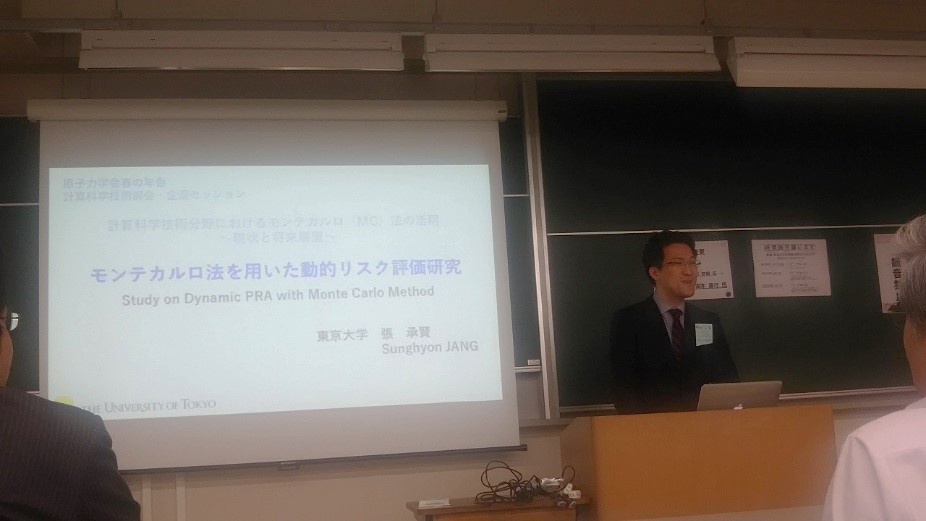
Shigeru Yonemura (Tohoku Univ.)
It was explained how the behavior of the lean fluid changes depending on Knudsen number and the outline of the DSMC method, one of the solving methods of the Boltzmann equation, was introduced. The simulation results of a cold microscale object located above the high temperature wall surface showed that the expected lift force works actually on the object.

-
Summary of planning lecture at 2017 Annual Meeting
Posted on November 28th, 2017 No commentsMon. March 27, 2017 1:00 PM – 2:30 PM
Room G (Tokai University)
”Credibility Assessment of Nuclear Simulations: State of the Art”
Chair person: Seiichi Koshizuka (The University of Tokyo)
Importance and necessity of verification and validation (V&V) is widely recognized in the simulation technology, and activities to establish the guidelines or standards for the simulation credibility are successfully performed in Japan and overseas. In the Atomic Energy Society of Japan, “Guideline for Credibility Assessment of Nuclear Simulations: 2015 (AESJ Guideline)” was published in July 2016. This AESJ Guideline presents the fundamental methodology of the V&V for modeling and simulation and the estimation of predictive capability incorporating with uncertainty quantification under high performance quality management system. In this session, publication process, expectations and issues on the guideline were presented.
(1)Publication of the AESJ Guideline for Simulation Credibility Assessment (in Japanese)
Kotaro Nakada (Toshiba)
The outline of the AESJ Guideline published on July 15, 2016 was presented. This guideline provides a framework to assess credibility of simulations and general concepts to perform the model V&V. It, therefore, describes a procedure of V&V for Modeling and Simulation and requires 4 elements for V&V: development of conceptual model, mathematical modeling, physical modeling and assessing predictability of simulation mode. A procedure to evaluate the uncertainties for prediction after V&V process is also described. Moreover, the outline of seminars on the guideline for spreading the fundamental concepts of assessment activities to acquire credibility of simulations was briefly reported in the presentation.
(2)Expectations for the AESJ Guideline for Simulation Credibility Assessment (in Japanese)
Masaki Shiratori (Yokohama National Univ.)
The Japan Society for Computational Engineering and Science (JSCES), in which speaker’ great effort has led the significant activities to enhance the quality assurance in computational engineering, published “Quality Management of Engineering Simulation”, “A Model Procedure for Engineering Simulation”, and supplemental document with the best practices in application of JSCES Standards. As expectations on the AESJ Guideline in viewpoint of simulation credibility assessment, it was emphasized that the predictive capability of the simulation for a specific purpose which applied to an internal or external events with low probability and high consequence in nuclear related facilities must be shown with high accountability, traceability, transparency and objectively. Additionally, the importance of implementation of the CFD grade experiments to support assurance of predictive capability of simulation was indicated.
(3)Issues and Challenges for Simulation Credibility Assessment (in Japanese)
Masaaki Tanaka (Japan Atomic Energy Agency)
In addition to the AESJ Guideline, “Standard Method for Safety Evaluation using Best Estimate Code Based on Uncertainty and Scaling Analyses with Statistical Approach: 2008” was published from the AESJ to ensure credibility of simulation in nuclear engineering. In foreign societies and organizations such as the American Nuclear Society, American Society of Mechanical Engineers (ASME), OECD/NEA, IAEA, the publication of guidelines regarding the V&V methodology was successfully progressed. In Japan, also, several activities regarding the V&V methodology and related studies have been carried out in, for instance, Japan Aerospace Exploration Academy (JAXA) and Applied Mechanics Committee of Japan Society Civil Engineering.
-
AWARD
Posted on July 18th, 2017 No commentsA list of recipients of Awards in CSED is added and updated for FY2016.
-
Update of Committees’ member and greeting in FY2017
Posted on May 30th, 2017 No commentsA greeting from Division head of FY2017, Dr. Masahiro Tatsumi (NEL) and the committes’ member of FY2017 are updated as follows;
-
Summary of planning lecture at 2016 Fall Meeting
Posted on March 31st, 2017 No commentsThu. Sep 8, 2016 1:00 PM – 2:30 PM
Room L (Kumume City Plaza – Assembly Room 2)
”Numerical Simulations for External Hazard Evaluation”
Chair person: Akemi Nishida (JAEA)
Evaluation of various external hazards is required while conducting inspections related to compliance of the new regulatory standards specified by the Nuclear Regulation Authority. However, since hazardous factors subject to evaluation are massive in scale with a lot of uncertainties (e.g. frequency and intensity of incidences), it is difficult to evaluate them by conducting regular testing. Generally, numerical simulations are used for this kind of evaluation, which is considered particularly effective for cases addressed in this session (excluding evaluation of earthquakes, which was done in a planning session in 2013). There remain several issues in simulations, including selection of an appropriate model and setting boundary conditions. It is not an easy task to get results that might provide any satisfactory explanation (adequacy).
In this session titled “Numerical simulations for evaluation of external hazards,” a series of lectures were given by experts for the results of simulating three phenomena, such as tsunami, tornado, and aircraft collision. The purpose is to show the appropriate use of numerical simulations for evaluating external hazards and to address issues related to enhancing the accuracy of simulation in the future. The number of audiences in this session was 41.
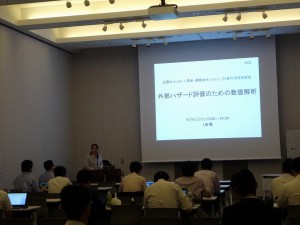
(1) Evaluation of Fluid Force Acted on Structures by Using Multi-Scale Particle Method
Speaker: Mitsuteru Asai (Kyushu Univ.)
Presesntation material (in Japanese)
In analyzing the tsunami force, there are many unknown factors in the mechanism of a tsunami acting on structures, and therefore, no clear design standards are established. This lecture presented an example of evaluating tsunami force affecting tsunami evacuation buildings and bridges, etc. using a multi-scale analysis tool based on the three-dimensional particle method.
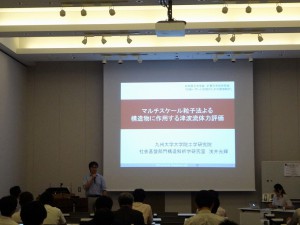
(2) Current Status on Numerical Simulation Methods to Evaluate Tornado Missile Hazard
Speaker: Yuzuru Eguchi (CRIEPI)
Presesntation material (in Japanese)
The design speed of tornado-generated missiles is indicated in NUREG1.76 of the NRC in the U.S., and the “Assessment guide for tornado effect on nuclear power plants” in Japan. This lecture presented how numerical simulations are used in these guides, and compared the results of numerical simulations with those of an evaluation method using the Fujita model, which is closer to the actual tornado velocity field.
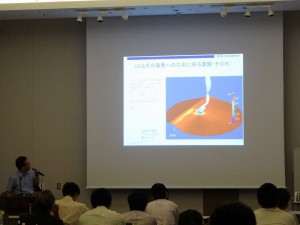
(3) Aircraft Impact Assessment for Nuclear Power Plant Design
Speaker: Haruji Tsubota (JAEA)
Presesntation material (in Japanese)
The nuclear power plant is required to maintain structural safety not only for natural disasters like earthquakes and tsunamis, but it must also be able to withstand possible aircraft collisions. In addressing the design of impact resistance for nuclear power plants against aircraft collisions, this lecture first reported the overview of the impact tests using an aircraft (F-4 Phantom), and then presented the latest trend of research for simulation analysis of a large civilian aircraft colliding into the nuclear power plant.
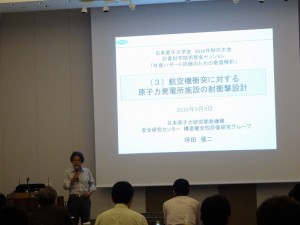
-
2017 Annual Meeting of AESJ
Posted on February 7th, 2017 No comments2017 annual meeting of AESJ will be held at Tokai University Shonan Campus on March 27-29. The meeting program is available on website. (Working language is Japanese.)
CSED related sessions are listed in the following.
(Password is required to access the abstracts and is issued for the participants only. A free access of the abstract will be available after a half year from the meeting.)
March 27th (Mon.) Room G (16-207 Building No. 16)
-
21st General meeting of CSED 12:00 – 13:00
-
Greeting of division chair (Akemi Nishida)
-
14th Awards ceremony in CSED dvision
-
Activity report from each committee
-
others
-
Planning Lecture “Credibility Assessment of Nuclear Simulations: State of the art”, 13:00 – 14:30
Chair: Seiichi Koshizuka (Univ. of Tokyo)
Abstracts (The password is required to access them and is issued for the participants only.)
-
Publication of the AESJ Guideline for Simulation Credibility Assessment, Kotaro Nakada (Toshiba )
-
Expectations for the AESJ Guideline for Simulation Credibility Assessment, Masaki Shiratori (Yokohama National Univ.)
-
Issues and Challenges for Simulation Credibility Assessment, Masaaki Tanaka (JAEA)
-
Oral presentations
-
Numerical simulation and Visualization of Thermal Fluid Dynamics and Nuclear Fuel, 10:00 – 11:55
Chair: Nakajima Norihiro (JAEA)
Abstracts (The password is required to access them and is issued for the participants only.)
[1G01] Interactive In-Situ Visualization of Molten Debris Relocation Simulation using Particle-based Visualization
[1G02] Numerical study on discharged flow of the accumulated solid particles from a glass melter
[1G03] Study on quench behavior at a core-disruptive accident for fast breeder reactors (32) Numerical simulations of jet breakup with the two-phase lattice Boltzmann method
[1G04] Development of preconditioned communication avoiding CG solver for multiphase CFD code JUPITER
[1G05] Study on Fuel Loading Pattern Optimization using Deep Learning and Reinforcement Learning (1)Prediction of Nuclear Characteristics of Reactor Core with Loading Pattern Infromation
[1G06] Study on fast reactor design with flexible consideration of fuel breeding and MA transmutation
[1G07] Development of seismic counter measures against cliff edges for enhancement of comprehensive safety of nuclear power plants
-
Numerical Analysis on Building and Structure Behavior on Earthquake, 14:45 – 16:40
Chair: Masahiro Tatsumi (NEL)
Abstracts (The password is required to access them and is issued for the participants only.)[1G08] Uncertainty assessment of the seismic response analysis due to various earthquake waves for nuclear facilities
[1G09] The study on advanced seismic simulation technology for huge plant
[1G10] Data analysis based upon abduction
[1G11] An element-by-element Finite Element Contact Analysis Method toward Seismic Behavior Analyses of an Entire Nuclear Facility: Verification Using a Stick Problem
[1G12] Performance Evaluation of Parallel FEA for Soil-structure Model using Manycore Processors
[1G13] Estimation of the fault parameter using dynamic rupture simulation by Bayesian Optimization
[1G14] A Study for Evaluating Local Damage to Structures Subjected to Oblique Impact Part1: A Study of the local damage evaluation of structures subjected to oblique impact of rigid projectile
-
Numerical Analysis on Damage of Structure and Defect in Materials, 16:40 – 18:00
Chair: Yoshio Suzuki (JAEA)
Abstracts (The password is required to access them and is issued for the participants only.)[1G15] A Study for Evaluating Local Damage to Structures Subjected to Oblique Impact Part1: A Study of the local damage evaluation of structures subjected to oblique impact of rigid projectile
[1G16] A Study for Evaluating Local Damage to Structures Subjected to Oblique Impact Part2: Analytical study on perforation damage caused by oblique impact of soft projectiles
[1G17] Study on local failure mechanism at high temperature by test and analysis
[1G18] MD simulations to evaluate stable configurations of vacancy-type defect clusters in Zirconium
[1G19] MD simulations to evaluate effects of stacking fault energies on defect formation process in crystalline materials under neutron irradiation (2)
-
-
Conference information
Posted on January 31st, 2017 No comments“CONFERENCE” tag is added and the following conference informations are updated.
ICCM2016
ICONE25
SMiRT24
TopSafe2017 -
Committe members
Posted on January 31st, 2017 No commentsCommitte members in FY2016 is added.
-
Greeting of division chair
Posted on January 31st, 2017 No commentsA greeting of division chair in FY2016 (Akemi Nishida, JAEA) is added.



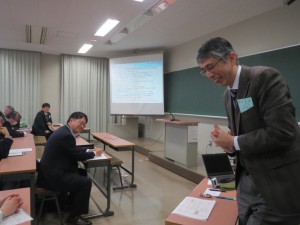

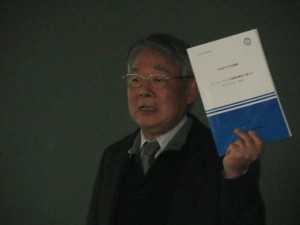

Recent Comments